
* In the mid-1960s, the Boeing company began studies for a new "jumbo jetliner" to meet growing demand for air travel, the design finally emerging as the "Boeing 747" late in the decade. It proved very successful in both jetliner and air freighter roles, and is still going strong in the 21st century. This document provides a history and description of the 747 series.
* In the mid-1960s, a race was underway between jetliner builders for ever more passenger capacity. "Stretches" of existing jetliners, such as the Boeing 707, were running out of steam, and so there was a drive towards new designs that were simply on a larger scale.
Under prodding by Pan American Airlines, Boeing began studies for a big jetliner in early 1966, with the formal go-ahead for development of the "747" granted in March of that year. Powerplants for the new upsized jetliner were an issue, existing turbofans being inadequate for such a big aircraft -- but both Pratt & Whitney (P&W) and General Electric (GE) were working on appropriately oversized turbofans for the US Air Force's (USAF) CX-HLS requirement for a heavy cargolifter, and so the appropriate engines would be available when needed. Boeing had designed a candidate for the CX-HLS competition, though it was won by Lockheed with the C-5 Galaxy.
Boeing used their CX-HLS concept as a starting point for the new jetliner, considering dozens of possible configurations, but finally decided on a "widebody" arrangement, with more than one passenger aisle. Ironically, the widebody scheme was chosen because the expectation was that the 747 would only be an interim type in the passenger liner role, to be quickly replaced by the supersonic transport (SST) jetliners then on the drawing board, and so the 747 would be most useful as an air freighter -- there being no economic sense in hauling bulk air freight on an SST. Of course, it would turn out there wasn't much more economic sense in hauling passengers on an SST either, and the 747 would hardly be an "interim type" as a jetliner. It would still be a very popular air freighter.
Along with the widebody configuration, there was consideration of multiple passenger decks, but that idea foundered on the difficulties of arranging passenger escape from the upper deck in case of an emergency. However, an upper deck crept back into the design when Pan Am suggested that the 747 air freighters have the option of a tilt-up nose for cargo loading. That meant placing the cockpit in a "bump" above the topline of the fuselage. As long as the bump was there, Boeing engineers decided to extend it backward to provide a crew rest area. Pan Am, however, wanted to use the bump for first-class seating, and so it was committed to passenger space, originally envisioned as accommodating eight first-class seats. The bump would become the 747's most distinctive recognition feature; more would be made of it.
Boeing had been diligent in addressing Pan Am's concerns, and so in April 1966 Pan Am placed an order for 25 747s at a cost of over a half-billion dollars -- at the time, a record buy. The program was formally launched in June of that year, with Boeing constructing a vast new factory at Everett, just north of Seattle, to build the new "jumbo jet", and lining up an extensive network of subcontractors. Boeing's investment in the 747 was of such magnitude that if the 747 failed, the company would certainly go bankrupt.
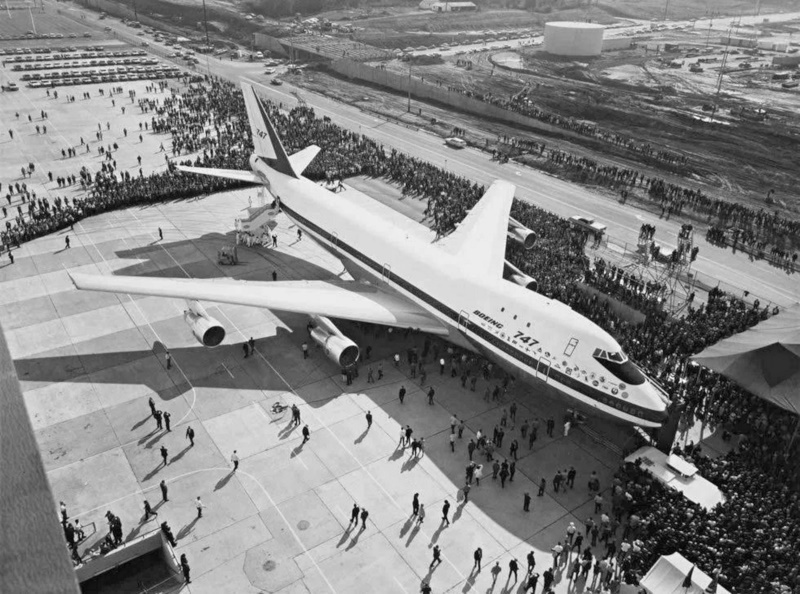
The 747 prototype -- officially, for some reason it wasn't supposed to be called a prototype -- was rolled out from the Everett plant on 30 September 1968, by which time Boeing had over 200 orders from 26 airlines. Initial flight was on 9 February 1969, the aircraft crew including pilot Jack Waddell, copilot Brien Wyglie, and flight engineer Jess Wallick. Before the flight, Boeing President Bill Allen was careful to make sure Waddell didn't feel excessively pressured: "Jack, I hope you understand that the future of the company rides with you this morning."
There were no show-stopper problems on the flight, with four more machines joining the test program. A 747 put on a performance at the Paris Air Show in 1969, with US certification being granted on 30 December 1969, and the first "747-100" jetliners being delivered in 1970. Pan Am performed the first service flight, from New York City to London, on 22 January 1970.
BACK_TO_TOP* The 747-100 provides a baseline for the 747 family. The basic configuration was that pioneered by the Boeing 707: a low-wing aircraft of all metal construction and all swept flight surfaces, with four turbofan engines mounted on pylons under the wings, and tricycle landing gear. Of course, the 747 was an entirely new aircraft, and on a substantially larger scale than the 707.
The wings had a sweepback of 35.5 degrees at quarter chord, with a dihedral of 7 degrees and an incidence of 2 degrees. There was a triple slotted flap inboard on each wing, followed by a high-speed aileron, then a triple slotted flap outboard, and a low-speed aileron near the tip. There were four flight spoilers ahead of the outboard flap and two ground spoilers / lift dumpers ahead of the inboard flap. There was a three-segment "flip-over" Krueger flap on the leading edge of each wing between the fuselage and the inboard engine, plus a drooping leading-edge flap in ten segments along the leading edge of the rest of the wing. The tail unit was of conventional configuration, with rudder and elevators; the incidence of the tailplane could also be adjusted for flight trim. All flight controls were hydraulically powered.
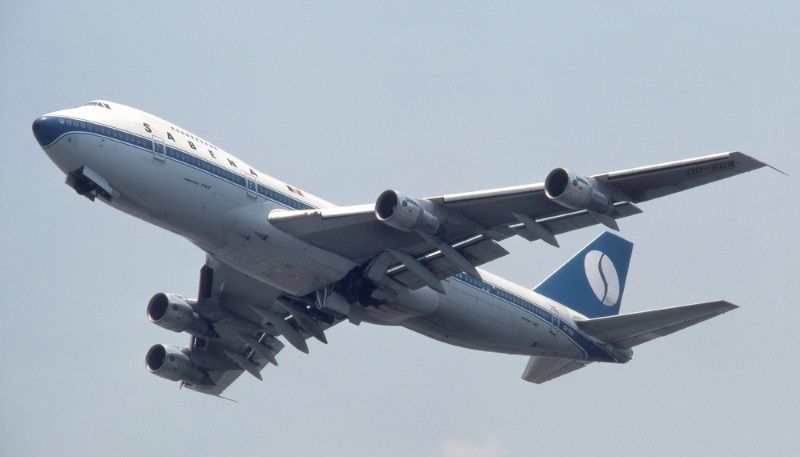
The 747-100 was powered by Pratt & Whitney (PW) JT9D high-bypass turbofans. The JT9D proved troublesome at the outset; the 747 had undergone "weight creep" during development, and the immature JT9D engines used in prototype development and early production could only generate 173.5 kN (17,690 kgp / 39,000 lbf) thrust, leaving the aircraft underpowered. Worse, these engines were very unreliable, big high-bypass turbofans being a painfully new technology, and were also afflicted by unforeseen problems -- thermal distortion of the cowlings that led to scratching of the tips of the turbine and compressor blades against the walls, plus difficulties with engine starting in crosswinds due to the oversized fan.
The worst problems were worked out, with the 747-100 going into service with the JT9D-3A variant, providing 204 kN (20,770 kgp / 45,800 lbf) thrust each. A Garrett auxiliary power unit (APU) was fitted to provide engine starting and ground power. There was a fuel tank in the wing center section, plus three fuel tanks in each wing, giving a total fuel supply of 178,702 liters (47,210 US gallons). There was a refueling point on each wing.
There was a single nose gear assembly, with two wheels and retracting forward, and four main gear assemblies, each with four wheels in a 2x2 bogie arrangement. Two of the main gear assemblies were mounted under the fuselage along the line of the trailing edge of the wings, and retracted forward; the other two were mounted forward, in the wings between the fuselage and inboard engine, and retracted inward toward the fuselage. Of course, the "busy" main gear was intended to support the 747's massive weight, and ensure that the aircraft didn't damage the tarmac.
___________________________________________________________________
BOEING 747-100:
___________________________________________________________________
wingspan:
59.6 meters (195 feet 8 inches)
wing area:
511 sq_meters (5,500 sq_feet)
length:
70.66 meters (231 feet 10 inches)
height:
19.3 meters (63 feet 5 inches)
empty weight:
162,400 kilograms (358,000 pounds)
MTO weight:
333,390 kilograms (735,000 pounds)
cruise speed:
895 KPH (555 MPH / 480 KT)
cruise altitude:
13,000 meters (35,000 feet)
range, max payload:
9,800 kilometers (6,100 MI / 5,300 NMI)
___________________________________________________________________
Avionics were conventional for the era, with radios, navigation aids, identification transponder, and a weather radar in the nose. There was a flight crew of three, with provision for one or two observers. Up to 500 passengers could be accommodated in a ten-across "cattle car" configuration; more reasonable accommodations were 447 seats, nine across, or 385 passengers, including 337 economy passengers and 48 first-class passengers, 16 of them seated in the upper deck. Of course, the aircraft was pressurized and climate-conditioned. There were five doors on each side of the aircraft. There were fore and aft cargo holds under the floor, with doors on the right side of the aircraft -- one door on the forward hold, two on the rear hold.
Although there were teething problems early in service -- the JT9D engines proving a particular trial -- the 747-100 became known as a safe and reliable aircraft. It was also surprisingly easy to fly, though handling such a huge machine on the ground presented challenges, most particularly from the fact that the cockpit crew were perched so high off the ground during taxi.
At the outset, in good part because of a global energy crisis and economic slowdown, airlines had trouble finding enough passengers to fill up the 747 every flight, and so for a few years sales of the 747 went soft in favor of smaller widebody jets, such as the Douglas DC-10. That seemed to vindicate critics who had suggested there was no way airlines could economically operate such a big jetliner. In some compensation for passengers, airlines didn't see any reason to cram passengers in, and so early on, low-density seating arrangements were the norm for the 747. Fortunately for Boeing but not so much for passengers, sales eventually picked up, and high-density seating arrangements became more common. However, it seems Boeing officials gradually concluded that the main selling point of the 747 was more range than passenger capacity.
BACK_TO_TOP* The 747-100's early JT9D-series engines still left something to be desired, but P&W continued to work on the design, leading to the first really satisfactory variant, the JT9D-7 series. The initial variant was only incrementally uprated, with 213 kN (21,725 kgp / 47,900 lbf) thrust, but it would provide a basis for substantially more powerful successors. More powerful engines resulted in 747 variants with increased take-off weights. Not all these variants had distinct designations, but they did lead, by steps, to the "747-100B" and then the "747-200B", with greater capacity and airframe reinforcements.
The 747-200B was introduced in early 1971. The 747-200B was almost identical externally to the 747-100, the only noticeable difference being ten passenger windows on each side of the upper deck on the 747-200, versus three on the 747-100. However, it appears that early 747-200B jetliners still had the three windows and some 747-100s were retrofitted with ten windows, so that is not a perfectly reliable recognition feature. Along with the new engines and other tweaks, the 747-200B also featured a bigger center wing section fuel tank, giving about 9% greater fuel capacity, for a total of 194,680 liters (51,430 US gallons).
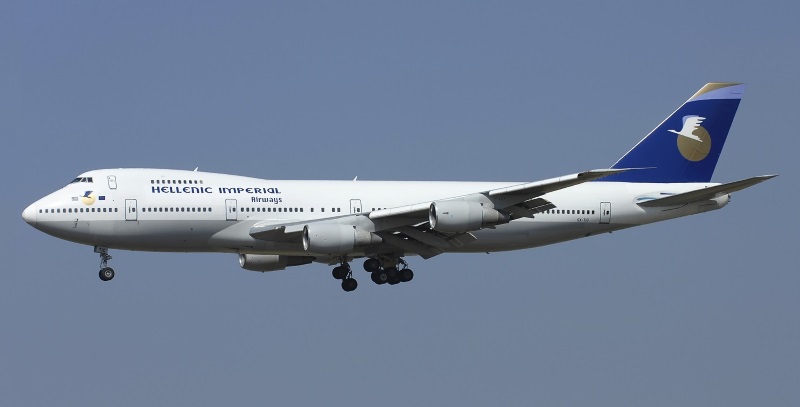
With the 747-200 series, Boeing diversified the 747 product offering, with customers able to select GE CF6 or Rolls-Royce RB211 turbofans, as well as the P&W JT9D, all engines being in the same thrust class. Boeing also introduced:
Incidentally, no 747-100 machines were built as freighters, even though there had been considerable customer interest in 747 freighters at the outset; the early JT9D engines just weren't powerful enough for the job. Boeing did rebuild two 747-100 jetliners as de facto "prototypes" for the 747-200M combi machine, and there were after-market freighter conversions of 747-100 machines phased out of jetliner service. Incidentally, it appears that combi configurations were popular -- since filling up a 747 with passengers might be problematic on some routes, it was attractive to use a single flight to haul both passengers and cargo.
A specialized "747-100SR" was developed for service in Japan; this variant was for short-haul routes, able to carry up to 528 passengers at the expense of range, and featured a reinforced fuselage to handle twice the number of pressurization-depressurization cycles. The 747-100SR went into service with Japan Air Lines (JAL) in 1973, with seven built; these machines were followed by the "747-100BSR" featuring higher take-off weight, with 20 built; and then two "747-100BSR (SUD)" with the "stretched upper deck (SUD)" developed for the Boeing 747-300, discussed below. That gave a total of 29 Series 100 short-range 747s, out of a total of 205 Series 100 machines built. Almost twice as many Series 200 machines were built as Series 100s, that total running to 393.
* In 1973, Boeing announced development of a derivative of the 747-100 for low-density / long-range intercontinental routes, this new machine being designated the "747 Special Performance (747SP)". Boeing simply chose to reduce the length of the 747-100 to 56.31 meters (184 feet 9 inches), which turned out to be trickier than it sounds. Stretching a jetliner by adding fuselage sections is nothing particularly unusual; cutting out sections of a baseline aircraft is not often done, and in this case it required certain changes to the airframe to get it to work.
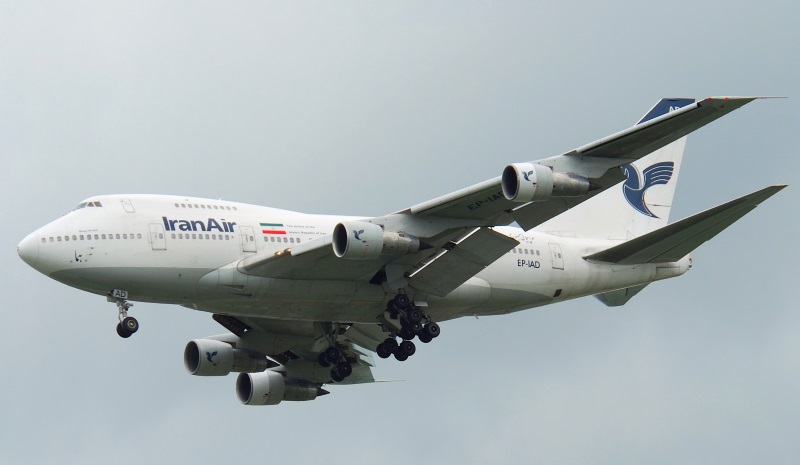
The shorter fuselage affected lateral stability, so the 747SP was given a taller tailfin; tailplane span was also increased, and the triple slotted flaps were traded for single slotted flaps -- the 747SP being the only 747 variant that didn't have multiple slotted flaps. Passenger capacity was up to 360 seats, though 305 was more reasonable; there were four doors on each side instead of five. Fuel capacity was the same as for the 747-100. Range was increased by about 9%.
Improvements in engine technology and the greater fuel capacity of the 747-200 made the 747SP redundant, and so only 45 747SP machines were sold. However, those that were sold were retained in service for a long time and had a good resale value, so it appears the 747SP worked well enough in its niche.
BACK_TO_TOP* From the mid-1970s, the global economy began to pick up, and sales of the 747 picked up with it. Airlines had less trouble filling seats, and in fact wanted more capacity for primary long-haul routes. Boeing considered stretching the 747, but decided instead to extend the upper deck by 7.1 meters (23 feet 4 inches), with the stretched upper deck increasing passenger topside accommodations in all-economy configuration from 32 to 91 passengers, six abreast with a single aisle; replacing the original spiral staircase to the upper deck with a straight staircase also freed up space on the main deck for seven more economy seats. The stretched upper deck could also accommodate 26 sleeper seats in a first-class configuration. The SUD featured an emergency exit on both sides; no doubt passengers riding an inflatable slide from that height found it an exciting experience. Exactly how passengers got out of the shorter upper decks with no emergency exits is an interesting little question.
Otherwise, the new "747-300" was similar to the 747-200, and in fact some sources claim a few early machines with the SUD were actually sold as 747-200 jetliners. It is established that a number of 747-200 machines in service were updated with the SUD, making them very hard to distinguish from 747-300 machines.
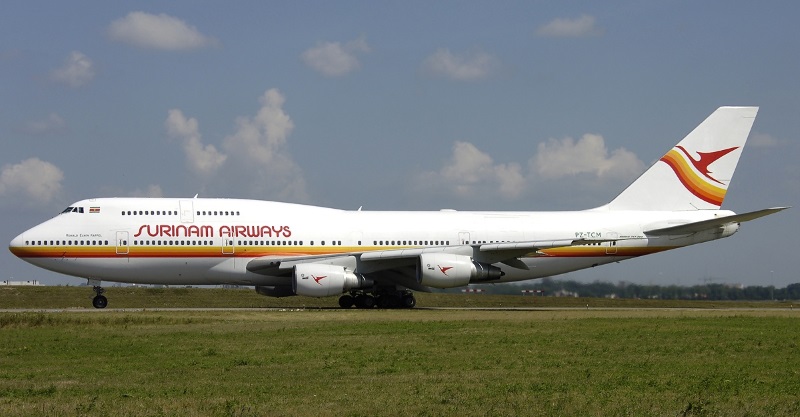
The 747-300 was announced in 1980, with certification and initial deliveries in 1983. A "747-300M" combi freighter was also sold, and sources mention sale of four "747-300SR" short-range machines to Japanese airlines, it seems with three additional windows on each side of the SUD for high-density seating. Some retired 747-300 jetliners were converted to freight configurations as well.
* Sales of the 747-300 were sluggish, however, and it ended up being something of an interim type, with only 81 built. In the face of slow sales, Boeing decided to use the 747-300 as the basis for a "second generation" 747, the "747-400", featuring:
___________________________________________________________________
BOEING 747-400:
___________________________________________________________________
wingspan:
66.44 meters (211 feet 5 inches)
wing area:
524.9 sq_meters (5,650 sq_feet)
length:
70.66 meters (231 feet 10 inches)
height:
19.41 meters (63 feet 8 inches)
empty weight:
180,958 kilograms (399,000 pounds)
MTO weight:
362,875 kilograms (800,000 pounds)
cruise speed:
920 KPH (570 MPH / 495 KT)
cruise altitude:
13,000 meters (35,000 feet)
range, max payload:
13,450 kilometers (8,355 MI / 7,260 NMI)
___________________________________________________________________
The 747-400 was announced in 1985, with the first machine delivered in early 1989. It proved very popular, with Boeing also producing:
* Given customer enthusiasm for the 747-400 series, Boeing considered possibilities for where to go from there. In response to the Airbus initiative to develop the A3XX series of "superjumbo jetliners", Boeing investigated a number of options for enhanced 747 models. In 1995:1996, the company considered stretched "747-500X" and "747-600X" variants, the second with a maximum passenger capacity of 700 seats, but abandoned those studies in 1997, partly due to doubts that the Airbus "superjumbo" concept was commercially sensible. Filling up so many seats seemed problematic to Boeing officials -- that having been an issue with the 747 to begin with.
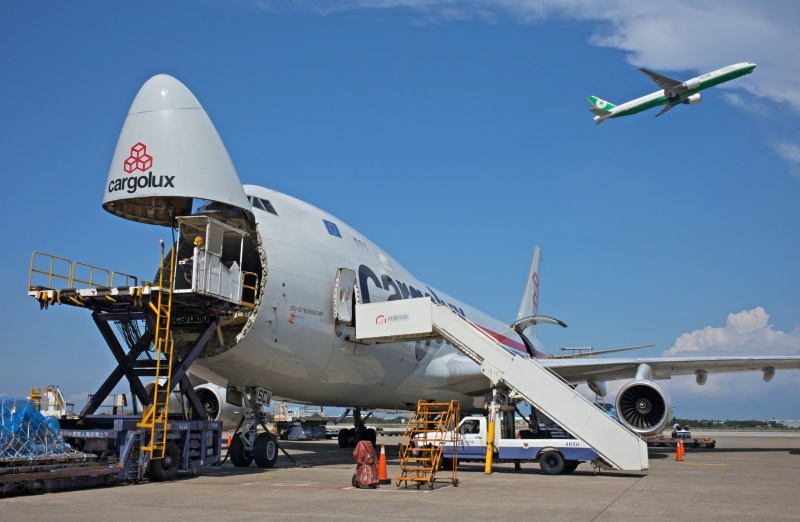
In any case, the company decided to pursue the lower-cost option of enhancing the existing 747-400 series. In 2000, the company focused on an extended range "747-400ER", originally simply the "Longer Range 747-400", a slightly updated version of the original 747-400. Boeing initiated production of the type in early 2002. The 747-ER had a reinforced wing and stronger landing gear, inherited from the 747-400F, and a modernized flight deck with multifunction flat-panel displays. The aircraft could carry up to 416 passengers in a more spacious seat layout and with greater overhead bin capacity, with range extended by about 6%. A "747-400ERF" freighter was also built.
The 747-400ER/ERF was the final 747-400 production variant -- but the popularity of the 747 series as an air freighter led Boeing to initiate a "747-400SF (Special Freighter)" conversion program for 747-400 jetliners in 2003, as a collaboration with Chinese partner firms. The primary modification was fit of a side cargo door. Total payload was 22,675 kilograms (50,000 pounds), with accommodation of 30 standard cargo pallets. Since 747-400 airliners had the extended upper deck for first-class passengers while 747-400F freighters didn't, the 747-400SF conversions were able to accommodate up to 19 passengers -- handy for transport of large animals that needed handlers and caretakers while in transit.
The last orders for a 747-400-series aircraft were taken in the summer of 2006; the last of 694 Series 400 machines were delivered in 2009. That gave a total of 1 + 205 + 45 + 393 + 81 + 694 == 1,419 first and second generation 747s built, almost half of them being 747-400 machines.
BACK_TO_TOP* Production of the 747 Series 400 was shut down to make way for a "third generation" aircraft, the "747-8", which Boeing announced in late 2005. After about a decade of tapdancing around on next-generation 747 variants, Boeing officials had to make it very clear to the industry that the 747-8 was for real.
Two variants were developed, including a "747-8 Passenger" AKA "747-8 Intercontinental (747-8I)" and "747-8 Freighter (747-8F)" cargolifter. The 747-8 was stretched 3.6 meters (11 feet 8 inches) compared to the 747-400, making it the first "stretch" 747 -- there was talk of making the 747-8I a bit shorter than the 747-8F, but they ended up being the same length. They were only offered with General Electric GEnx-2B67 engines, with 296 kN (30,160 kgp / 66,500 lbf) thrust each. This engine was developed for the Boeing 787 -- Boeing, it appears, had grown weary of supporting multiple engine types, to form a close alliance with GE. The turbofans featured the serrated noise-reducing cowlings introduced on the 787.
The 747-8 featured a modernized glass cockpit and wing. The wing retained the same sweep and general arrangement, but was reprofiled, and featured increased span; it had raked wingtips instead of winglets. It had double slotted flaps inboard along with single slotted flaps outboard, instead of the triple slotted flaps of its direct predecessors.
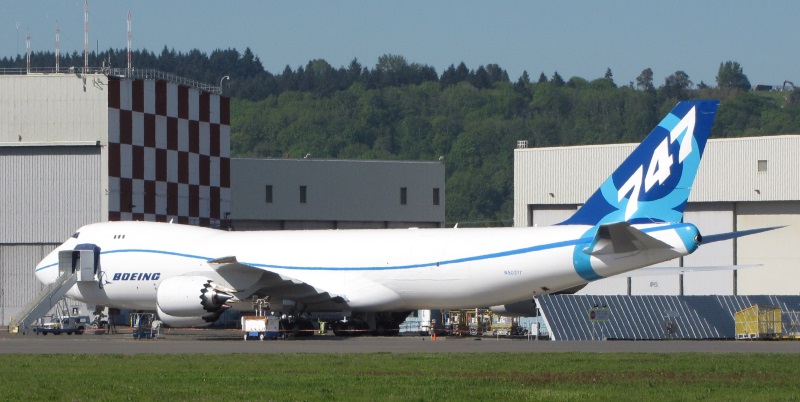
Maximum passenger capacity for the 747-8I was 605 seats, or 467 in a three-class arrangement; the upper deck was stretched to allow more passenger capacity topside. The interior was modernized, along the lines of that developed for the 787, with the same color-controlled LED lighting scheme, as well as bigger windows -- though they had sliding blinds, not the electronic dimming used on the 787. The 747-8F had a cargo capacity of 140 tonnes (154 tons), 16% more than the 747-400F. It had both nose and side cargo doors, but did not have the stretched upper deck. Pilots flying the 747-8 did not require a new type rating, a problem that afflicted earlier attempts to define a next-generation 747.
___________________________________________________________________ BOEING 747-8I: ___________________________________________________________________ wingspan 68.45 meters (224 feet 7 inches) wing area 560 sq_meters (6,028 sq_feet) length 76.25 meters (250 feet 2 inches) height 19.35 meters (63 feet 6 inches) empty weight 295,000 kilograms (651,000 pounds) MTO weight 448,000 kilograms (987,000 pounds) cruise speed 920 KPH (570 MPH / 495 KT) service ceiling 13,000 meters (43,000 feet) range 14,800 kilometers (9,210 MI / 8,000 NMI) The 747-8F has about 10% greater empty weight and, with a full cargo load, about 55% of the range. ___________________________________________________________________
The 747-8F was the first into service, with initial flight in 2010 and initial customer deliveries in 2011. By industry standards, shipping an air freighter variant before shipping an airliner variant was backwards, but not so surprising in this case given the popularity of the 747-400F. Following introduction, the 747-8 was improved; at introduction, the aircraft was slightly under its fuel efficiency specs, but thanks to refinements to the GEnx-2B67 engines -- plus other tweaks, such weight reduction and smarter software for the flight management system -- it ended up slightly exceeded specs.
The 747-8 was not a big seller; by 2018, there had been less than 50 orders for the 747-8I, a bit over 100 orders for the 747-8F. Weak sales then encountered the COVID-19 pandemic of 2020, which hit air transport very hard. In 2020, Boeing announced that 747 production would end in 2022, after a half-century run. The last one, a 747-8F, was delivered in early 2023.
* As a footnote, a number of 747 jetliners, including the 747-8I, were either obtained new as VIP configurations, or refurbished to them -- such machines officially known as "Boeing Business Jets (BBJs)". Buyers notably included the governments of Saudi Arabia, Brunei, Oman, the UAE, and Japan. Configurations varied as per customer specification; government 747 BBJs may well have been given defensive countermeasures. It appears that some BBJs were directly purchased from Boeing, with a subcontractor organization doing the conversion work, but in other cases, the company doing the configuration was in the driver's seat. Lufthansa Technik of Germany performed at least 14 such VIP conversions.
BACK_TO_TOP* The 747 has seen some military use, the best-known being two "VC-25A" 747-200B-based machines used by the USAF to fly the President of the United States (POTUS) and his entourage around. They are usually referred to as "Air Force One" -- but strictly speaking, that's the callsign for any aircraft carrying the POTUS.
The program to obtain the two machines was begun in 1985, during the Reagan Administration, with the first performing its initial flight on 16 May 1987, followed by the second on 23 October 1987. The aircraft were delivered in the 1990s. They are powered by GE CF6 engines.
The VC-25 externally looks generally like a stock 747-200B, the most noticeable difference being a bump on the nose for an inflight refueling receptacle -- they also have a long-range fuel tank configuration, and an augmented engine oil supply to allow the aircraft to stay in the air for long periods, it seems up to six days. Of course, it features an extensive "farm" of antennas for secure global communications.
Another, subtler external difference is the door arrangement; the VC-25As do appear to retain the normal 747-200B door scheme -- the POTUS will use the forward left exit to make a "presidential" exit down red-carpeted stairs -- though some of the exits may have been plugged. However, they also have an "airstair" mounted low fore and aft on the left side of the aircraft, for use at airstrips where normal airport flight handling facilities are not available.
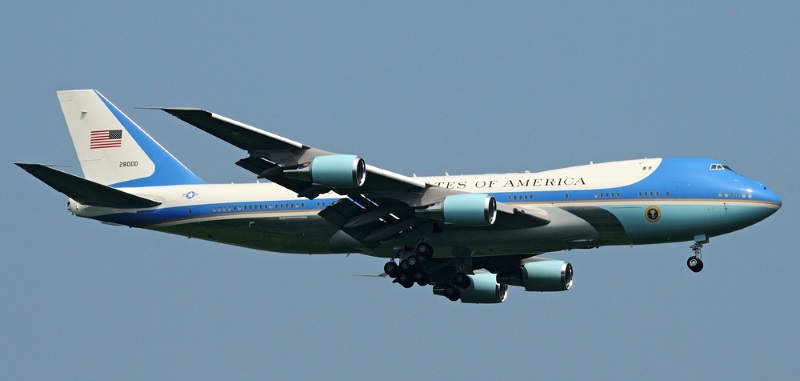
Internally, the VC-25 has been fitted with a custom VIP interior -- though it's not particularly plush, more a working machine than something like a flying luxury yacht for a billionaire. The bottom cargo holds include freezers for storing meals; a VC-25A on a mission carries enough provisions to keep all on board fed for the duration of a mission, which as noted might well be a number of days of continuous flight time. The upper deck behind the cockpit includes a crew rest area and a communications center. The main deck provides passenger facilities, including, from front to back:
There are of course toilets, and it appears a small secondary galley in the rear. The VC-25A machines also feature a defensive countermeasures system; unsurprisingly no details have been published, but observers have noted an AN/AAR-54 missile warning system on the tail and twin AN/AAQ-24 Nemesis directed infrared countermeasures (DIRCM) turrets to "dazzle" heat-seeking missiles. The avionics systems are "hardened" against the electromagnetic pulse (EMP) of a nuclear blast. Given their custom avionics, it's not surprising that these two aircraft have twice as much wiring as an ordinary 747-200B.
Security associated with flights of a VC-25 is unsurprisingly tight and thorough. The presidential 747s are now over a quarter century old; they haven't seen much hard use -- their flight schedules being far less burdensome than those of a 747 in full-time commercial service, each VC-25 only logging about 360 flight hours a year -- but in 2015, the Air Force announced that the 747-8 would be acquired as a replacement platform. Two 747-8s were purchased from Boeing, being machines ordered by a Russian airline that went broke. Modification started in 2019, with fielding from 2026.
* Four customized 747-200B machines are also used by the Air Force as the "E-4 Advanced Airborne Command Post". They were ordered in the early 1970s to replace current EC-135J flying command posts, with one interim-spec "E-4A" delivered in 1973, two more E-4A machines delivered in 1975, and a full-spec "E-4B" delivered in 1979. The three E-4A machines were all updated to E-4B spec by 1985.
The E-4B aircraft are intended to be used as flying command posts for the POTUS and other senior officials in case of all-out war. Like the VC-25A machines, they have an inflight refueling socket in the nose; a custom interior with quarters, conference rooms, and control centers; comprehensive communications avionics; and EMP hardening. The E-4B has a distinctive recognition feature in the form of a fairing for a satellite communications (SATCOM) antenna behind the upper deck; it has a farm of other antennas, including a long wire antenna that can be reeled out from the tail for low frequency communications with submarines. The fairing was not fitted to the E-4A machines, which had less sophisticated systems in general, and it seems weren't EMP hardened -- their kit apparently having been ported from the old EC-135J machines.
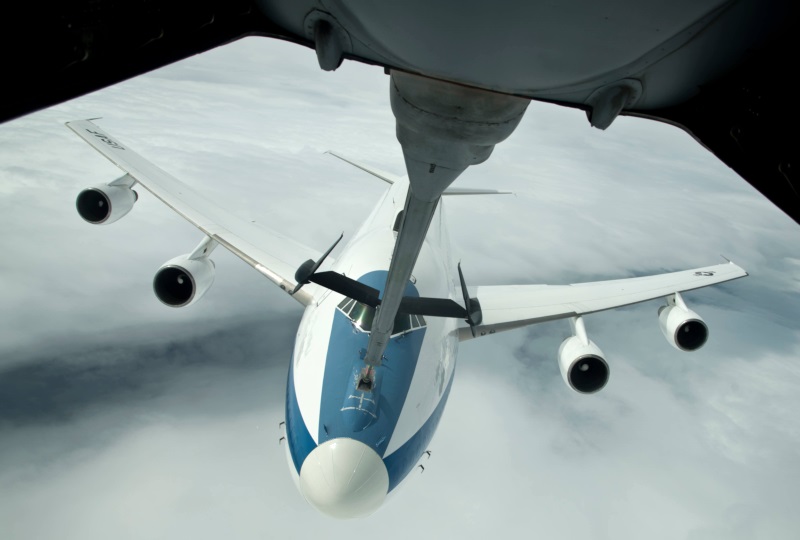
It seems that the VC-25A aircraft can also perform the flying command post role, leaving the E-4B machines somewhat underutilized. As a result, the E-4B aircraft have ended up being flying command posts for disaster relief operations on occasion as well. The E-4Bs have been updated in service; the Air Force is now looking to replace them, as they are nearing the end of their flight lives.
* The only other operational 747 aircraft associated with the US military were about 18 or 19 747s of various descriptions, modified from 1985 with a side cargo door and cargo handling kit by Boeing for "combi" operations as part of the Civil Reserve Air Fleet (CRAF) -- that being an arrangement in which civil companies operated the aircraft, but the Air Force had them on call in an emergency. These aircraft were given the designation of "C-19A"; their current status is unclear.
Boeing did push the 747 for a number of other military roles, including military cargolifter, various missile launcher configurations, a maritime patrol configuration, and a "KC-747" tanker -- but though a 747 was mocked up with a tanker boom for flight tests, the Air Force didn't bite on any of them. One particularly fascinating study was for a "flying aircraft carrier", hauling around a set of Boeing-designed "microfighters". The little jet fighters were released and recovered via bays fore and aft of the 747's wing, with a boom refueling probe being used to snag a fighter for recovery, a trapeze system then extending from the bay to haul it in. Of course, the two refueling booms also could be used to top off fighters without recovering them. An "airborne warning and control system" variant was considered along with it, but they never amounted to more than pipe dreams.
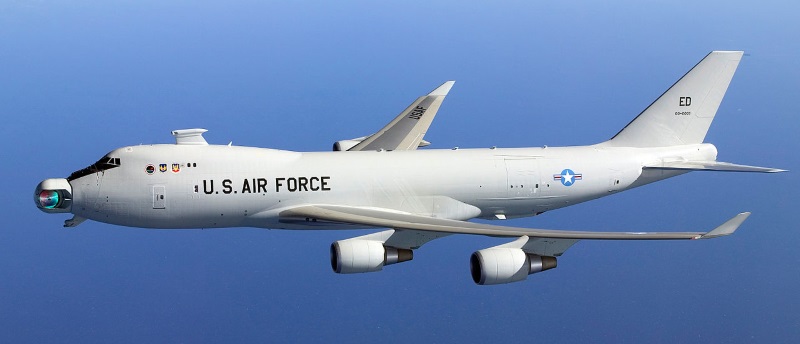
The USAF did, however, convert one 747 to what might be referred to as a "Star Wars Laser battleship", the "YAL-1A Airborne Laser (ABL)", to test out a high-power "chemical oxygen-iodine laser (COIL)" weapon, fired from a nose turret to intercept missiles from long range. The YAL-1A was modified from 747-400F air freighter, Boeing performing the work at the company facility in Wichita, Kansas, the modified aircraft performing its initial flight in 2002. Getting the COIL to work was problematic, and though the Air Force wanted to acquire a fleet of seven operational aircraft, the effort was scaled back to a purely experimental effort in 2009, with the YAL-1A mothballed in early 2012.
* Iran acquired a set of 747s for military use before the fall of the Shah. Details of these aircraft are very unclear and contradictory; it appears that 16 used aircraft were obtained, and generally operated as combi transports. However, two or three of them were fitted with inflight refueling booms by Boeing, making them the only 747 inflight refueling tankers on the planet. Some sources claim they were also fitted with pods for hose-&-drogue refueling, but such photos as are available don't support that notion. The flight status of these aircraft is unclear; the Iranians have been resourceful about keeping old military hardware working, and there's a fair international aftermarket for old 747 parts, so they may remain airborne.
BACK_TO_TOP* There have been plenty of civil modifications of 747 aircraft, some of them exotic. Among the more familiar were two "Shuttle Carrier Aircraft (SCA)", used by the US National Aeronautics & Space Administration (NASA) to haul the NASA space shuttle orbiter cross-country, most typically from Edwards Air Force Base in California, the shuttle alternate landing site, to Kennedy Space Center in Florida, the launch site and (after early shuttle flights) primary landing site.
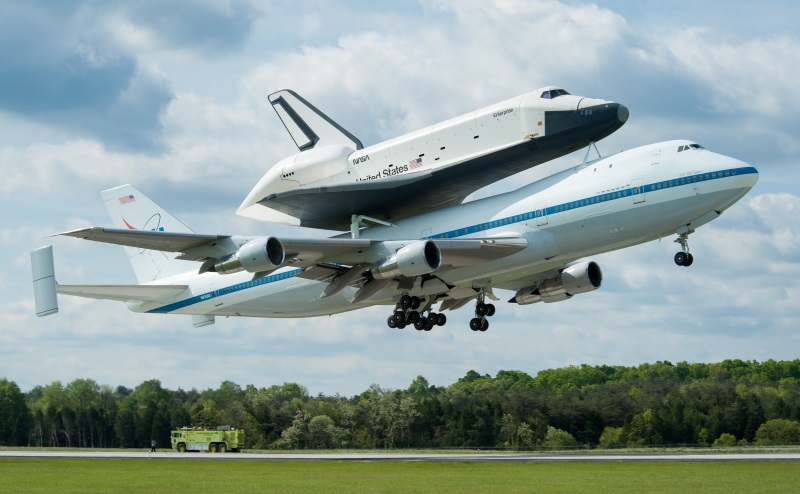
The SCAs were both used 747-100-series machines, acquired in the mid-1970s, fitted out with struts on the back for mounting the orbiter, with the orbiter mounted by a special crane fixture. Large endplate fins were mounted on the tips of the tailplane to compensate for the aerodynamic interference of the shuttle. The bulky payload cut badly into the 747's range, making the transcontinental trip time-consuming since it required multiple fuel stops. The SCAs were also used early in the program for drop tests of the orbiter, and on occasion to haul other large payloads around. They were retired at the end of the shuttle program in 2012, the original plan being to use them as spares hulks; one didn't prove to be a useful source of spares, so it was put on display at the Houston Space Flight Center, with the mockup shuttle INDEPENDENCE on its back.
* The spare assemblies provided by the grounded SCA were primarily used to support the "Stratospheric Observatory For Infrared Astronomy (SOFIA)", a 2.5-meter (98-inch) infrared telescope mounted in a Boeing 747SP. Infrared light tends to be blocked by water vapor, and so it's difficult to perform telescopic observations in the infrared from the ground. Infrared observations can be obtained from orbit, or (over shorter durations) by high-flying balloons or aircraft. From 1974 to 1995, NASA flew the "Kuiper Airborne Observatory (KAO)", a converted Lockheed C-141A Starlifter four-jet transport aircraft carrying a 91-centimeter (36-inch) reflecting infrared telescope.
The KAO's replacement, SOFIA, started out in a collaboration established in 1997 between NASA and the German Aerospace Center (DLR in its German acronym), with a contract awarded that year to the "Universities Space Research Association (USRA)" for construction and operation of SOFIA. The American members of the team were responsible for the aircraft, and the Germans were responsible for the infrared telescope.
Used 747-200 and 747SP airframes were both considered for SOFIA; the 747SP was found to be much cheaper and entirely sufficient for the task. The 747SP obtained by USRA had entered service in 1978, originally with Pan Am, being sold to United in 1986. It had 40,000 flight hours on it when obtained by USRA, but it proved to be in excellent condition, with no major structural repair needed -- though engine, auxiliary power unit, and landing gear were overhauled. Raytheon Systems performed the updates to turn the aircraft into a flying observatory, installing control systems for the telescope, a "flying classroom", and the telescope mounting section.
The infrared telescope was mounted in the rear fuselage, and featured a stabilized mount with a precision pointing system. A configuration was also considered with the telescope forward of the wing, but that would have demanded a pressurized tunnel between the forward and rear fuselage through the telescope bay, adding considerably to cost. The telescope peered through a door on the left side of the fuselage with dimensions of 5.5 x 4.1 meters (18 x 13.5 feet) that extended for a quarter of the aircraft's circumference.
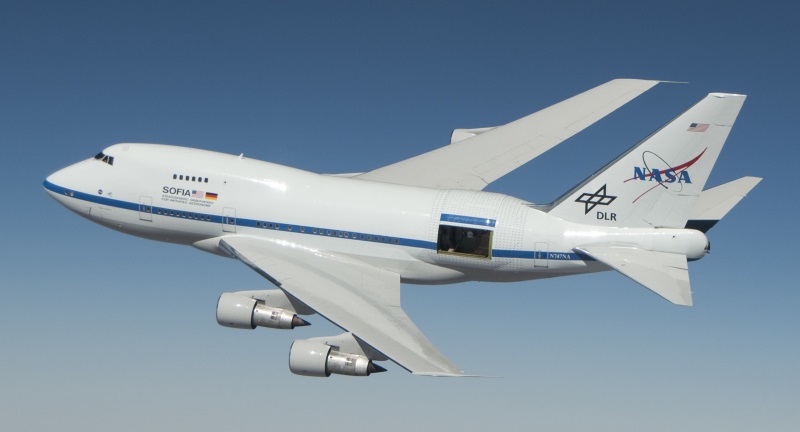
Despite the presence of this "gaping hole" in the fuselage, no modifications of the aircraft's flight surfaces, like the SCA's tailplane endplates, were necessary -- though ballast had to be loaded into the aircraft's nose to maintain trim given the heavy weight of the telescope assembly, about 18,180 kilograms (40,000 pounds). Even with the ballast, however, the overall aircraft load was easily within the payload capacity of the 747SP. After several years of painful delays and complications, SOFIA's initial test flights began in 2009, with first observations performed in 2010. SOFIA was expected to fly for 20 years -- but it was retired in 2022. It was simply too expensive to operate, and space-based infrared observatories were able to do its job.
* In another space-related application, Richard Branson's Virgin Galactic operation flew a Boeing 747-400 named "Cosmic Girl", previously in service with Virgin Atlantic Airways, as the carrier aircraft for the firm's "LauncherOne" air-launched booster. LauncherOne was a liquid-fuel rocket vehicle, capable of placing 200 kilograms (440 pounds) of payload into Sun-synchronous low Earth orbit.
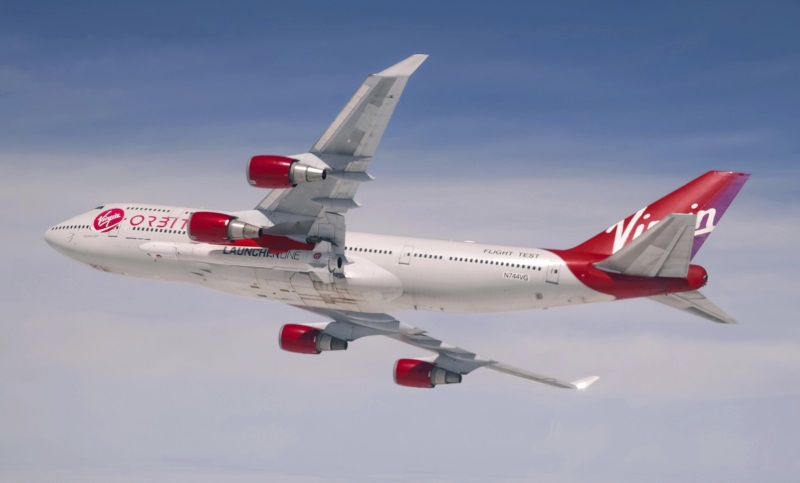
Although the carrier was originally envisioned as the custom-made Virgin Galactic "White Knight" aircraft, weight of the booster dictated a 747. The booster was carried on a pylon under the 747's left wing, between the fuselage and inboard engine. The jetliner was stripped of all unnecessary kit, with airframe reinforcements added to allow it to handle the load. Operations were out of the Virgin Galactic site in Mojave, California. There were a number of delays in the program, with the first launch attempt in 2020 suffering a booster failure. The second launch, on 17 January 2021, was successful, with ten small satellites placed in orbit. Four more launches were performed to early 2023, all successful except for the fourth -- which was the first launch from Cornwall in the UK. It was also the first space launch attempt from Britain, and a big disappointment. It was also the last launch attempt, since Virgin Galactic then went broke.
* Boeing created a set of "Large Cargo Freighter (LCF)" aircraft, based on used 747-400 airframes, for support of the company's 787 program. The LCF or "Dreamlifters" featured an enlarged "guppy" fuselage, with a tail assembly that broke at the aft pressure bulkhead and swung open to the left. Cargo volume was three times that of a standard 747-400 air freighter, and in fact it had more cargo volume than any other aircraft ever flown. The LCF could carry bulky payloads, with a maximum radius of 3.76 meters (12 feet 4 inches); the assemblies carried were relatively lightweight, and so no need was seen to modify a freighter 747, which had greater load capacity.
The tailfin was increased in height by 1.5 meters (5 feet) and forward ballast was added to compensate for aerodynamic and center-of-gravity changes caused by the enlarged fuselage. The cargo bay was heated but not pressurized. The tail was supported by a stand when the aircraft was being loaded and unloaded, with the stand carried with the aircraft. The aircraft deck was selectively reinforced and integrated roller systems to help load and unload cargo.
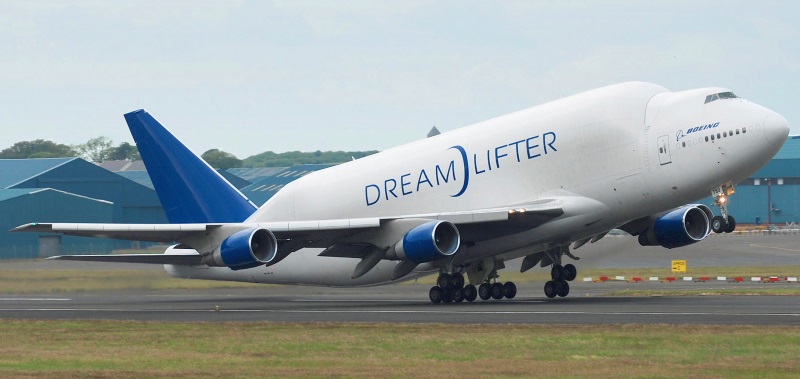
Three were built, with a Boeing partner in Taiwan doing the work, and the first beginning trials in early 2007. Other than the changes to the airframe, the aircraft did not receive any serious modifications, such as the latest engines and avionics, and the modified fuselage was built out of plain old aircraft aluminum, not fancy composite materials. At last notice, they remain in service.
* Evergreen Aviation of the USA converted two 747 machines into a "Supertanker" configuration for fighting forest fighters, these aircraft featuring a set of appropriate modifications:
The Supertanker was designed as a system that could be operated at any airport capable of handling a 747. Ground support equipment, aside from that normally required for a large commercial aircraft, consisted of a fork lift and a large bladder tank that was filled from a fire hydrant. The Supertanker was rapidly reloaded from the bladder tank using a hose-and-reel system fitted into the aircraft.
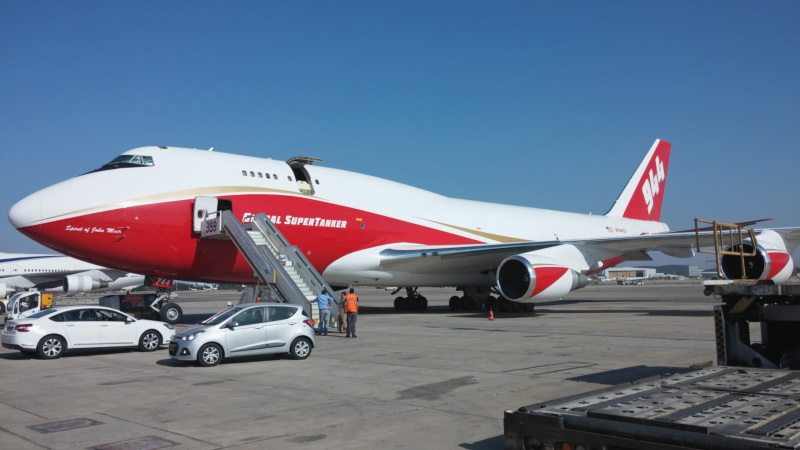
Initial flight of the first Supertanker, a converted 747-200 combi machine, was in 2004, though this machine never saw service. It was followed by a 747-100 conversion, which conducted its initial operational flights in 2009. There was consideration of further conversions, but Evergreen went bankrupt in December 2013.
That wasn't quite the end of the SuperTanker. A firm named Global SuperTanker Services LLC bought up the SuperTanker and its kit, with the gear removed from the 747-100 and installed in a 747-400 freighter -- the greater engine power of the 747-400 being seen as a definite plus over the 747-100 for the fire-fighting role. However, it proved uneconomical to operate and was retired in 2021.
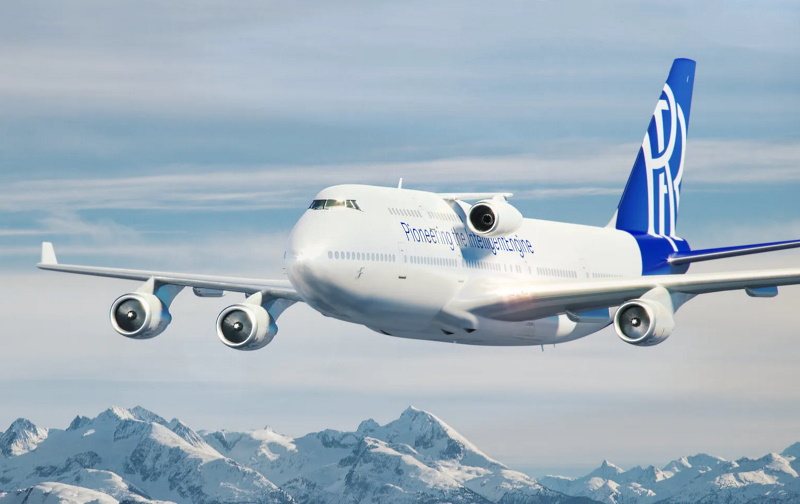
747s have been flown as trials platforms as well. Rolls-Royce acquired a used 747-200 in 2007 to use as an engine testbed. The company acquired a 747-400, previously flown by Quantas, in 2019, to rig it with a stub wing at the left rear of the extended flight deck, also for running engine tests. It is flown out of Tucson, Arizona.
BACK_TO_TOP* I talk to retired flyboys over email every now and then, including a few ex-747 pilots. On querying them about the handling of the 747, they can be eloquent in its praise -- for example:
BEGIN QUOTE:
I've flown the -100 through the -400 models, and they all generally handled the same -- effortlessly. Imagine dancing with a tall, heavy woman, who, despite her lack of swimsuit model looks, glides around the floor in your arms like Ginger Rogers. You forget the size and weight, because the hydraulically boosted controls respond to fingertip inputs. In other words, it flies just as it looks to an observer on the ground. The relatively small cockpit was a minor annoyance, but all in all, a wonderful airplane.
END QUOTE
It seemed like such an intimate revelation that I felt a bit embarrassed.
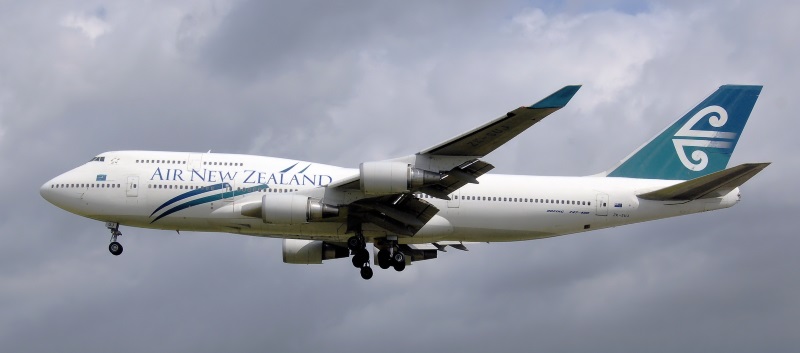
* Sources include:
Other sources included my library of JANE'S ALL THE WORLD'S AIRCRAFT volumes, the online Wikipedia, and Boeing online documents.
* Illustrations credits:
* Revision history:
v1.0.0 / 01 may 13 v1.0.1 / 01 apr 15 / VC-25 comments. v1.0.2 / 01 mar 17 / New VC-25 order. v1.0.3 / 01 feb 19 / Review, update, & polish. v1.0.4 / 01 jan 21 / Review, update, & polish. v1.0.5 / 01 mar 21 / Follow-on corrections. v1.0.6 / 01 feb 23 / Review, update, & polish. v1.0.7 / 01 feb 25 / Review, update, & polish. (+)BACK_TO_TOP
